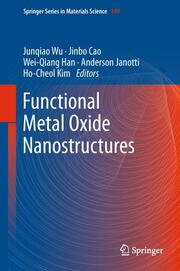-
Zusatztext
-
InhaltsangabePreface 1. New Opportunities on Phase Transitions of Correlated Electron Nanostructures 1.1. Introduction 1.2. Electrical and Structural Transitions in VO2 1.3. Experimental Methods 1.4. Results and Discussions 1.4.1. Phase Inhomogeneity and Domain Organization 1.4.2. Domain Dynamics and Manipulation 1.4.3. Investigation of Phase Transition at the Single Domain Level 1.4.4. Superelasticity in Phase Transition 1.4.5. New Phase Stabilization with Strain 1.4.6. Thermoelectric Across the Metal-Insulator Domain Walls 1.5. Conclusions2. Controlling the Conductivity in Oxide Semiconductors 2.1. Introduction 2.2. Formalism and Computational Approach 2.3. Results and Discussion 2.3.1. ZnO 2.3.2. SnO2 2.3.3. TiO2 2.4. Concluding Remarks 3. The Role of Defects in Functional Oxide Nanostructures 3.1. Introduction 3.2. Defects in Metal Oxide Nanostructures 3.2.1. Defect Structures in Metal Oxide Nanostructures3.2.2. Imaging Defects in Metal Oxide Nanostructures 3.2.3. Stability of Intrinsic Point Defects in Metal Oxide Nanostructures 3.3. Electrical Response 3.3.1. Point Defects and Charge Carriers 3.3.2. Defects and P-Type Conductivity 3.3.3. Defects and Conduction Mechanisms 3.3.4. Plasmon Response in Defect-Rich Oxide Nanostructures 3.4. Optical Response 3.4.1. Photoluminescence from Point Defects in Oxide Nanostructures 3.4.2. Raman Studies on Oxide Nanostructures 3.4.3. Magneto-Optical Properties of Oxide Nanostructures 3.5. Magnetic Response 3.5.1. Magnetism in Metal Oxide Nanoparticles 3.5.2. Ferromagnetism in Defect-Rich Semiconducting Metal Oxides 3.5.3. Spin Polarization in Defect-Rich Metal Oxide Nanostructures 3.5.4. Mechanisms for Magnetism in Metal Oxide Nanostructures 3.6. Defect Engineering in Metal Oxide Nanostructures 3.7. Conclusions4. Emergent Metal-Insulator Transitions Associated with Electronic Inhomogeneities in Low-Dimensional Complex Oxides 4.1. Introduction 4.2. Experimental Approach 4.2.1. Fabrication of Spatially Confined Oxide Nanostructures 4.2.2. Cryogenic Four-Probe STM 4.3. Results and Discussion4.3.1. Percolative Mott Transition in Sr3(Ru1-xMnx)2O7 4.3.2. Confinement Effects and Tunable Emergent Behavior in La5/8-xPrxCa3/8MnO3 4.4. Conclusion 5. Optical Properties of Nanoscale Transition Metal Oxides 5.1. Physical, Chemical and Size-Shape Tunability in Transition Metal Oxides 5.2. Optical Spectroscopy as a Probe of Complex Oxides 5.3. Quantitative Models 5.3.1. Confinement Models 5.3.2. Descriptions of Inhomogeneous Media 5.3.3. Inhomogeneous Media and Surface Plasmons 5.3.4. Charge and Bonding Models 5.4. ChargeStructureFunction Relationships in Model Nanoscale Materials 5.4.1. Mott Transition in VO2 Revealed by Infrared Spectroscopy 5.4.2. Visualizing Charge and Orbitally Ordered Domains in La1/2Sr3/2MnO4 5.4.3. Discovery of Bound Carrier Excitation in Metal Exchanged Vanadium Oxide Nanoscrolls and Size Dependence of the Equatorial Stretching Modes 5.4.4. Classic Test Cases: Quantum Size Effects in ZnO and TiO2 5.4.5. Optical Properties of Polar Oxide Thin Films and Nanoparticles 5.4.6. Spectroscopic Determination of H2 Binding Sites and Energies in Metal-Organic Framework Materials 5.5. Summary and Outlook6. Electronic Properties of Post-Transition Metal Oxide Semiconductor Surfaces 6.1. Introduction 6.2. Surface Space-Charge Properties 6.2.1. ZnO 6.2.2. Ga2O3 6.2.3. CdO 6.2.4. In2O3 6.2.5. SnO2 6.3. Bulk Band Structure Origin of Electron Accumulation Propensity 6.4. Conclusion
-
-
Kurztext
-
Addresses a hot area of electronic and magnetic materialsCovers basic properties, synthesis, processing, and applicationsFocuses on nanoscale aspects of metal oxidesPresents both recently developed theories and state-of-the-art applicationsIncludes supplementary material: sn.pub/extras
-
Detailansicht
Functional Metal Oxide Nanostructures
Springer Series in Materials Science 1003, Springer Series in Materials Science 149
ISBN/EAN: 9781441999306
Umbreit-Nr.: 1684480
Sprache:
Englisch
Umfang: xi, 368 S.
Format in cm:
Einband:
gebundenes Buch
Erschienen am 21.09.2011
Auflage: 1/2011


